Charactering Human-Caused Fires Using GIS-Based Dimensionality Reduction Techniques in Keelung City, Taiwan
Abstract
:1. Introduction
2. Materials and Methods
2.1. Study Area and Dataset
2.2. Geospatial Data Preparation
2.2.1. Fire Density over the Past 10 Years
2.2.2. Population Density
2.2.3. Proportion of Elderly Population
2.2.4. Proportion of Elderly Living Alone Population
2.2.5. Proportion of Young Age Population
2.2.6. Building Density
2.2.7. Proportion of Buildings over 40 Years Old
2.2.8. Proportion of Non-Reinforced Concrete (RC) Buildings
2.2.9. Proportion of First, Secondary, and Tertiary Sectors of the Economy
3. Dimensionality Reduction Techniques
3.1. Principal Component Analysis
3.2. Factor Analysis
3.3. Out-of-Bag Predictor Importance
4. Results
4.1. Identification of Factors Contributing to Human-Caused Fires
4.2. Implication of the Identified Components
5. Discussion
- (1)
- Building Safety Upgrades: It is advisable to implement safety upgrade initiatives in areas characterized by densely populated and aging structures. This involves renovating electrical systems and maintaining older structures to enhance their fire resistance [57]. Additionally, prioritizing the inspection of older buildings is essential. Moreover, utilizing multi-sensor and information fusion technology for early detection and alarm systems in building fires can also help reduce the risk of fires [58]. Strengthening the monitoring and inspection of older buildings is crucial to ensure compliance with current fire safety standards and to encourage necessary renovations and enhancements.
- (2)
- Industrial Oversight: Several research findings indicate that effective fire safety measures encompass fire-related training, fire evacuation drills, functional fire alarms, establishment of fire emergency exits and escape plans, and knowledge of fire hazards [59,60,61]. In areas with a high density of tertiary sector activities, it is recommended to enforce stricter industrial regulations. This involves ensuring that businesses in these zones comply with fire prevention and emergency response regulations, thereby mitigating the risk of fires.
- (3)
- Elderly Population Safety: Risk factors such as reduced mobility, impaired cognitive ability, mental disorders, and smoking were observed among the elderly [62]. It is advisable to focus efforts on villages with a higher concentration of elderly residents. This includes raising awareness of fire safety, engaging in advocacy initiatives, and enhancing fire prevention measures in the living environments of the elderly.
6. Conclusions
Author Contributions
Funding
Institutional Review Board Statement
Informed Consent Statement
Data Availability Statement
Conflicts of Interest
References
- Duarte, L.; Teodoro, A.C. An easy, accurate and efficient procedure to create Forest Fire Risk Maps using Modeler (SEXTANTE plugin). J. For. Res. 2016, 27, 1361–1372. [Google Scholar] [CrossRef]
- Jiménez-Ruano, A.; Rodrigues Mimbrero, M.; de la Riva Fernández, J. Exploring spatial–temporal dynamics of fire regime features in mainland Spain. Nat. Hazards Earth Syst. Sci. 2017, 17, 1697–1711. [Google Scholar] [CrossRef]
- Himoto, K. Comparative analysis of post-earthquake fires in Japan from 1995 to 2017. Fire Technol. 2019, 55, 935–961. [Google Scholar] [CrossRef]
- Lee, C.A.; Sung, Y.C.; Lin, Y.S.; Hsiao GL, K. Evaluating the severity of building fires with the analytical hierarchy process, big data analysis, and remote sensing. Nat. Hazards 2020, 103, 1843–1856. [Google Scholar] [CrossRef]
- Sakellariou, S.; Parisien, M.A.; Flannigan, M.; Wang, X.; de Groot, B.; Tampekis, S.; Christopoulou, O. Spatial planning of fire-agency stations as a function of wildfire likelihood in Thasos, Greece. Sci. Total Environ. 2020, 729, 139004. [Google Scholar] [CrossRef] [PubMed]
- Fernandez-Anez, N.; Krasovskiy, A.; Müller, M.; Vacik, H.; Baetens, J.; Hukić, E.; Solomun, M.K.; Atanassova, I.; Glushkova, M.; Bogunović, I.; et al. Current wildland fire patterns and challenges in Europe: A synthesis of national perspectives. Air Soil Water Res. 2021, 14, 11786221211028185. [Google Scholar] [CrossRef]
- McDonough, L.K.; Treble, P.C.; Baker, A.; Borsato, A.; Frisia, S.; Nagra, G.; Paterson, D. Past fires and post-fire impacts reconstructed from a southwest Australian stalagmite. Geochim. Cosmochim. Acta 2022, 325, 258–277. [Google Scholar] [CrossRef]
- Huang, H.; Lin, C.; Wang, S.; Su, C.; Chen, L. Stack effects in tall building fires: A case study of Taiwan old apartment fire. Sci. Rep. 2022, 12, 8963. [Google Scholar] [CrossRef]
- Chang, R.H.; Tso, Y.E.; Lin, C.H.; Kwesell, A. Challenges to the Fire Service–Centric Emergency Management System. Nat. Hazards Rev. 2022, 23, 05021017. [Google Scholar] [CrossRef]
- Pivello, V.R.; Vieira, I.; Christianini, A.V.; Ribeiro, D.B.; da Silva Menezes, L.; Berlinck, C.N.; Overbeck, G.E. Understanding Brazil’s catastrophic fires: Causes, consequences and policy needed to prevent future tragedies. Perspect. Ecol. Conserv. 2021, 19, 233–255. [Google Scholar] [CrossRef]
- Cassidy, P.; McConnell, N.; Boyce, K. The older adult: Associated fire risks and current challenges for the development of future fire safety intervention strategies. Fire Mater. 2021, 45, 553–563. [Google Scholar] [CrossRef]
- Karemaker, M.; Ten Hoor, G.A.; Hagen, R.R.; van Schie, C.H.; Boersma, K.; Ruiter, R.A. Elderly about home fire safety: A qualitative study into home fire safety knowledge and behaviour. Fire Saf. J. 2021, 124, 103391. [Google Scholar] [CrossRef]
- Laban, M.; Milanko, V.; Kočetov Mišulić, T.; Draganić, S. Fire statistics and risk analysis in wooden building structures in Serbia. Int. Wood Prod. J. 2017, 8, 62–70. [Google Scholar] [CrossRef]
- Federal Emergency Management Agency. Socioeconomic Factors and the Incidence of Fire; Federal Emergency Management Agency: Washington, DC, USA, 1997. [Google Scholar]
- National Fire Agency, Ministry of the Interior, Taiwan. Analysis of National Fire Statistics for the Year; Ministry of the Interior: New Taipei City, Taiwan, 2021. [Google Scholar]
- Keelung City Fire Bureau. Overview of Fire Statistical Analysis in Keelung City for the Year; Keelung City Fire Bureau: Keelung City, Taiwan, 2021. [Google Scholar]
- National Fire Agency, Ministry of the Interior. Available online: https://www.nfa.gov.tw/cht/index.php?code=list&ids=220 (accessed on 1 November 2023). (In Chinese)
- Keelung City Fire Bureau. Available online: https://www.klfd.klcg.gov.tw/en/klfd2 (accessed on 1 November 2023). (In Chinese)
- Zhao, X.; Guo, J.; Nie, F.; Chen, L.; Li, Z.; Zhang, H. Joint principal component and discriminant analysis for dimensionality reduction. IEEE Trans. Neural Netw. Learn. Syst. 2019, 31, 433–444. [Google Scholar] [CrossRef] [PubMed]
- Tsutsumida, N.; Murakami, D.; Yoshida, T.; Nakaya, T.; Lu, B.; Harris, P. Geographically Weighted Non-negative Principal Components Analysis for Exploring Spatial Variation in Multidimensional Composite Index. GeoComputation 2019, 2019. [Google Scholar]
- Acal, C.; Aguilera, A.M.; Escabias, M. New modeling approaches based on varimax rotation of functional principal components. Mathematics 2020, 8, 2085. [Google Scholar] [CrossRef]
- Hasan BM, S.; Abdulazeez, A.M. A review of principal component analysis algorithm for dimensionality reduction. J. Soft Comput. Data Min. 2021, 2, 20–30. [Google Scholar]
- Jiménez-Ruano, A.; Mimbrero, M.R.; de la Riva Fernández, J. Understanding wildfires in mainland Spain. A comprehensive analysis of fire regime features in a climate-human context. Appl. Geogr. 2017, 89, 100–111. [Google Scholar] [CrossRef]
- San-Miguel, I.; Coops, N.C.; Chavardès, R.D.; Andison, D.W.; Pickell, P.D. What controls fire spatial patterns? Predictability of fire characteristics in the Canadian boreal plains ecozone. Ecosphere 2020, 11, e02985. [Google Scholar] [CrossRef]
- Daşdemir, İ.; Aydın, F.; Ertuğrul, M. Factors affecting the behavior of large forest fires in Turkey. Environ. Manag. 2021, 67, 162–175. [Google Scholar] [CrossRef] [PubMed]
- Fréjaville, T.; Curt, T. Spatiotemporal patterns of changes in fire regime and climate: Defining the pyroclimates of south-eastern France (Mediterranean Basin). Clim. Chang. 2015, 129, 239–251. [Google Scholar] [CrossRef]
- Zerbe, K.; Polit, C.; McClain, S.; Cook, T. Optimized hot spot and directional distribution analyses characterize the spatiotemporal variation of large wildfires in Washington, USA, 1970–2020. Int. J. Disaster Risk Sci. 2022, 13, 139–150. [Google Scholar] [CrossRef]
- Kaufman, M.M.; Rosencrants, T. GIS method for characterizing fire flow capacity. Fire Saf. J. 2015, 72, 25–32. [Google Scholar] [CrossRef]
- Nyimbili, P.H.; Erden, T. GIS-based fuzzy multi-criteria approach for optimal site selection of fire stations in Istanbul, Turkey. Soc.-Econ. Plan. Sci. 2020, 71, 100860. [Google Scholar] [CrossRef]
- Truong, T.X.; Nhu, V.H.; Phuong DT, N.; Nghi, L.T.; Hung, N.N.; Hoa, P.V.; Bui, D.T. A New Approach Based on TensorFlow Deep Neural Networks with ADAM Optimizer and GIS for Spatial Prediction of Forest Fire Danger in Tropical Areas. Remote Sens. 2023, 15, 3458. [Google Scholar] [CrossRef]
- Elhag, M.; Yimaz, N.; Bahrawi, J.; Boteva, S. Evaluation of optical remote sensing data in burned areas mapping of Thasos Island, Greece. Earth Syst. Environ. 2020, 4, 813–826. [Google Scholar] [CrossRef]
- Annas, S.; Kanai, T.; Koyama, S. Principal component analysis and self-organizing map for visualizing and classifying fire risks in forest regions. Agric. Inf. Res. 2007, 16, 44–51. [Google Scholar] [CrossRef]
- Marinho AA, R.; de Gois, G.; de Oliveira-Júnior, J.F.; Correia Filho WL, F.; de Barros Santiago, D.; da Silva Junior, C.A.; Rogério, J.P. Temporal record and spatial distribution of fire foci in State of Minas Gerais, Brazil. J. Environ. Manag. 2021, 280, 111707. [Google Scholar] [CrossRef] [PubMed]
- Rodrigues, M.; Jiménez-Ruano, A.; de la Riva, J. Fire regime dynamics in mainland Spain. Part, 1: Drivers of change. Sci. Total Environ. 2020, 721, 135841. [Google Scholar] [CrossRef]
- Van Pham, T.; Do TA, T.; Tran, H.D.; Do AN, T. Assessing the impact of ecological security and forest fire susceptibility on carbon stocks in Bo Trach district, Quang Binh province, Vietnam. Ecol. Inform. 2023, 74, 101962. [Google Scholar] [CrossRef]
- Fatricia, R.S.; Daryanto, A.; Sutanto, J. Developing and validating a scale for anxiety over land and forest fire. Int. J. Disaster Risk Reduct. 2023, 95, 103850. [Google Scholar] [CrossRef]
- Khan, Z.; Gul, N.; Faiz, N.; Gul, A.; Adler, W.; Lausen, B. Optimal trees selection for classification via out-of-bag assessment and sub-bagging. IEEE Access 2021, 9, 28591–28607. [Google Scholar] [CrossRef]
- Goretzko, D.; Ruscio, J. The comparison data forest: A new comparison data approach to determine the number of factors in exploratory factor analysis. Behav. Res. Methods 2023, 1–14. [Google Scholar] [CrossRef] [PubMed]
- Hindle, B.J.; Rees, M.; Sheppard, A.W.; Quintana-Ascencio, P.F.; Menges, E.S.; Childs, D.Z. Exploring population responses to environmental change when there is never enough data: A factor analytic approach. Methods Ecol. Evol. 2018, 9, 2283–2293. [Google Scholar] [CrossRef]
- Genuer, R.; Poggi, J.M.; Tuleau-Malot, C.; Villa-Vialaneix, N. Random forests for big data. Big Data Res. 2017, 9, 28–46. [Google Scholar] [CrossRef]
- Gale, M.G.; Cary, G.J.; Van Dijk, A.I.; Yebra, M. Untangling fuel, weather and management effects on fire severity: Insights from large-sample LiDAR remote sensing analysis of conditions preceding the 2019–2020 Australian wildfires. J. Environ. Manag. 2023, 348, 119474. [Google Scholar] [CrossRef]
- Wall, W.A.; Hohmann, M.G.; Just, M.G.; Hoffmann, W.A. Characterizing past fire occurrence in longleaf pine ecosystems with the Mid-Infrared Burn Index and a Random Forest classifier. For. Ecol. Manag. 2021, 500, 119635. [Google Scholar] [CrossRef]
- Department of Civil Affairs, Keelung City Government. Available online: https://www.klcg.gov.tw/tw/civil (accessed on 1 November 2023). (In Chinese)
- Nowak, M.M.; Dziób, K.; Ludwisiak, Ł.; Chmiel, J. Mobile GIS applications for environmental field surveys: A state of the art. Glob. Ecol. Conserv. 2020, 23, e01089. [Google Scholar] [CrossRef]
- Oyinna, B.; Okedu, K.E.; Diemuodeke, O.E.; David, L.E.; Negedu, I.O.; Osemudiamen, E.A.; Kalam, A. Assessing small hydropower sites in Nigeria for sustainable development using ArcGIS. Energy Rep. 2023, 10, 2889–2898. [Google Scholar] [CrossRef]
- Department of Social Affairs, Keelung City Government. Available online: https://www.klcg.gov.tw/tw/social (accessed on 1 November 2023). (In Chinese)
- Department of Urban Development, Keelung City Government. Available online: https://www.klcg.gov.tw/tw/urban (accessed on 1 November 2023). (In Chinese)
- Department of Economic Affairs, Keelung City Government. Available online: https://www.klcg.gov.tw/en/klcg2/3285-128527.html (accessed on 1 November 2023). (In Chinese)
- World Health Organization. World Report on Ageing and Health; World Health Organization: Geneva, Switzerland, 2015. [Google Scholar]
- Mutmainnah, W.; Bowo, L.P.; Nurwahyudy, A.; Prasetyo, F.A.; Furusho, M. Causative factor analysis of passenger ship accident (Fire/Explosion) in Indonesia. In IOP Conference Series: Earth and Environmental Science; IOP Publishing: Bristol, UK, 2020; Volume 1, p. 012037. [Google Scholar]
- Moler, C.; Little, J. A history of MATLAB (Matrix Laboratory). In Proceedings of the ACM on Programming Languages, 4(HOPL); Association for Computing Machinery: New York, NY, USA, 2020; pp. 1–67. [Google Scholar]
- Ahmadi, M.T.; Aghakouchak, A.A.; Mirghaderi, R.; Tahouni, S.; Garivani, S.; Shahmari, A.; Epackachi, S. Collapse of the 16-story Plasco building in Tehran due to fire. Fire Technol. 2020, 56, 769–799. [Google Scholar] [CrossRef]
- Farinha, J.; Cunha, L.; Dimuccio, L.A. Exploratory Spatial Analysis of Social Vulnerability and Forest Fire Risk in the Pinhal Interior Sul (Central Portugal). Sustainability 2022, 14, 3010. [Google Scholar] [CrossRef]
- Garcia-Castillo, E.; Paya-Zaforteza, I.; Hospitaler, A. Fire in heritage and historic buildings, a major challenge for the 21st century. Dev. Built Environ. 2023, 13, 100102. [Google Scholar] [CrossRef]
- Gupta, V.; Hidalgo, J.P.; Lange, D.; Cowlard, A.; Abecassis-Empis, C.; Torero, J.L. A review and analysis of the thermal exposure in large compartment fire experiments. Int. J. High-Rise Build. 2021, 10, 345–364. [Google Scholar]
- Chen, C.; Reniers, G.; Khakzad, N. A thorough classification and discussion of approaches for modeling and managing domino effects in the process industries. Saf. Sci. 2020, 125, 104618. [Google Scholar] [CrossRef]
- Rush, D.; Bankoff, G.; Cooper-Knock, S.J.; Gibson, L.; Hirst, L.; Jordan, S.; Walls, R.S. Fire risk reduction on the margins of an urbanizing world. Disaster Prev. Manag. Int. J. 2020, 29, 747–760. [Google Scholar] [CrossRef]
- Ren, X.; Li, C.; Ma, X.; Chen, F.; Wang, H.; Sharma, A.; Masud, M. Design of multi-information fusion based intelligent electrical fire detection system for green buildings. Sustainability 2021, 13, 3405. [Google Scholar] [CrossRef]
- Kurata, Y.B.; Ong AK, S.; Prasetyo, Y.T.; Dizon, R.M.; Persada, S.F.; Nadlifatin, R. Determining factors affecting perceived effectiveness among filipinos for fire prevention preparedness in the national capital region, Philippines: Integrating protection motivation theory and extended theory of planned behavior. Int. J. Disaster Risk Reduct. 2023, 85, 103497. [Google Scholar] [CrossRef]
- Ding, L.; Khan, F.; Ji, J. Risk-based safety measure allocation to prevent and mitigate storage fire hazards. Process Saf. Environ. Prot. 2020, 135, 282–293. [Google Scholar] [CrossRef]
- Wunder, S.; Calkin, D.E.; Charlton, V.; Feder, S.; de Arano, I.M.; Moore, P.; Vega-García, C. Resilient landscapes to prevent catastrophic forest fires: Socioeconomic insights towards a new paradigm. For. Policy Econ. 2021, 128, 102458. [Google Scholar] [CrossRef]
- Steen-Hansen, A.; Storesund, K.; Sesseng, C. Learning from fire investigations and research–A Norwegian perspective on moving from a reactive to a proactive fire safety management. Fire Saf. J. 2021, 120, 103047. [Google Scholar] [CrossRef]
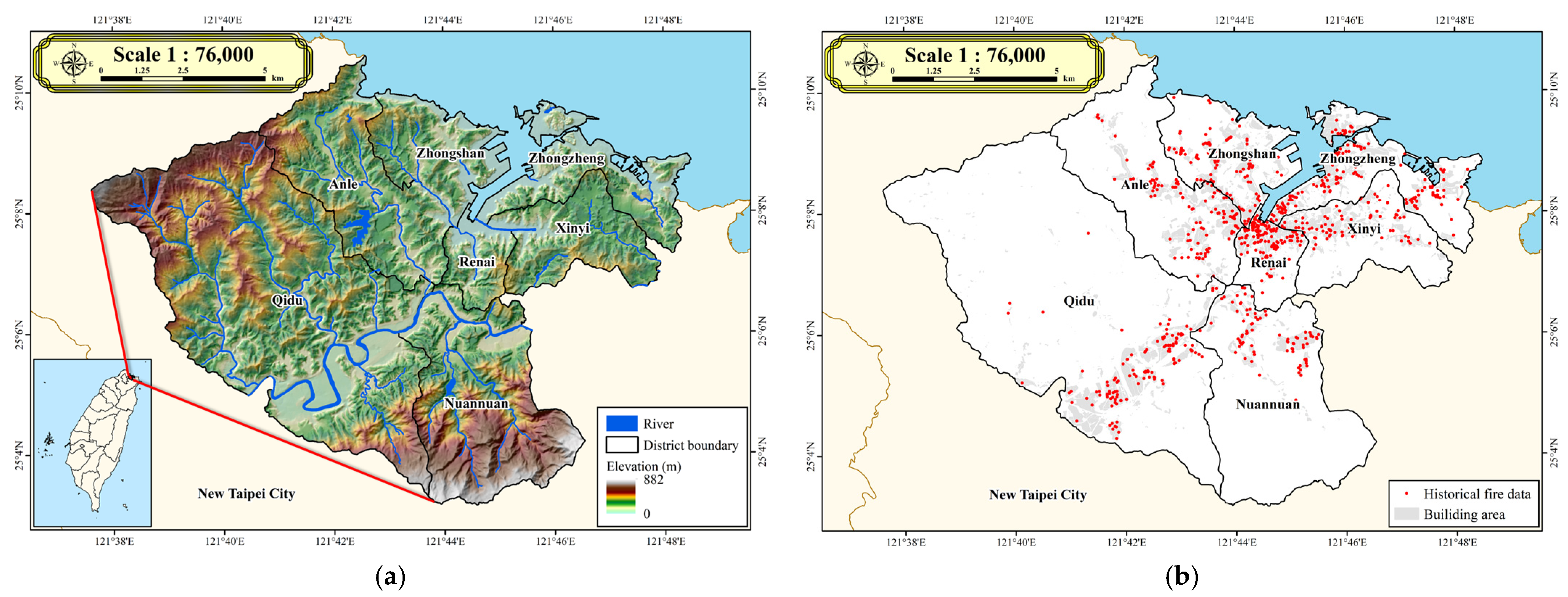
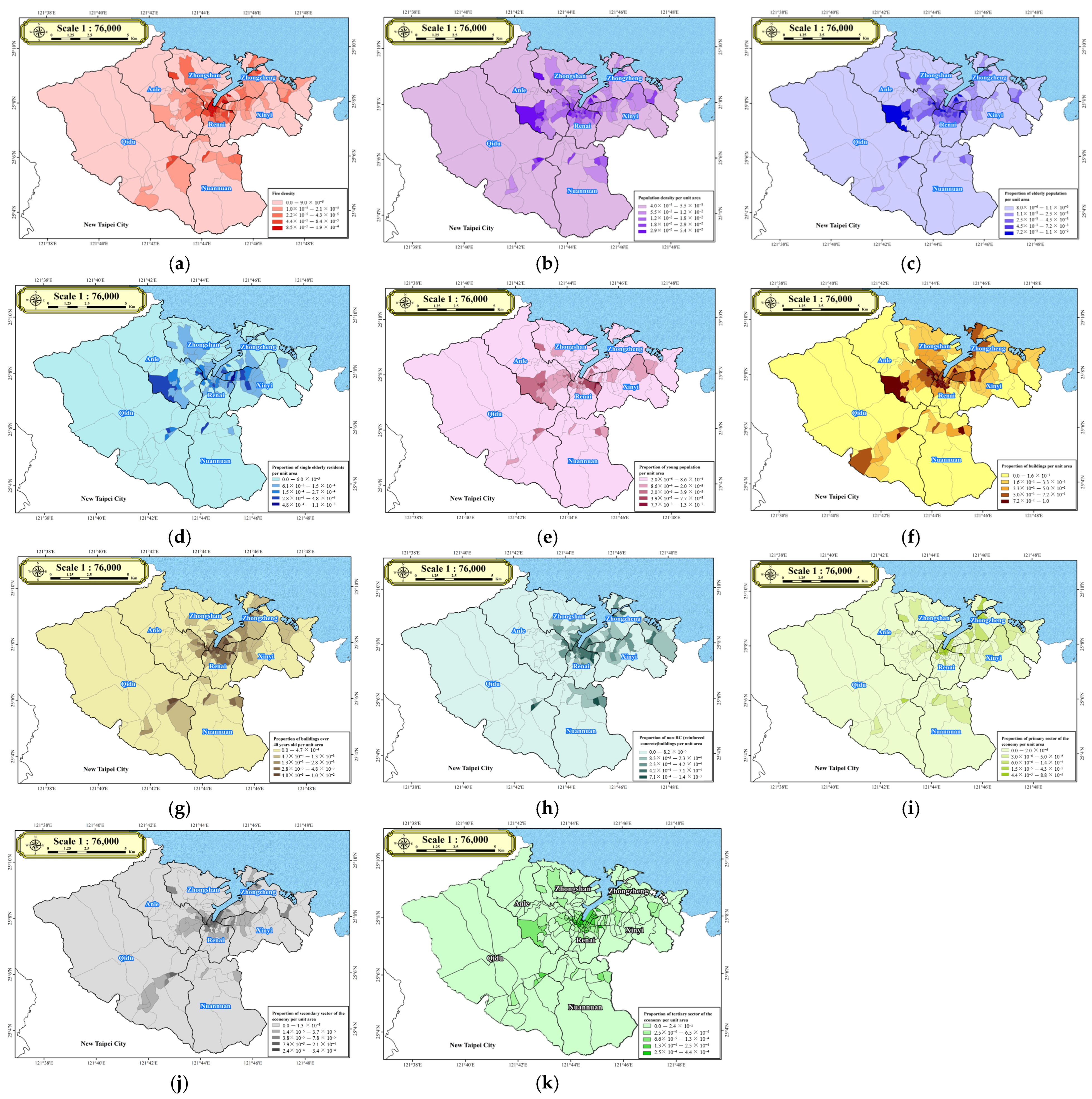
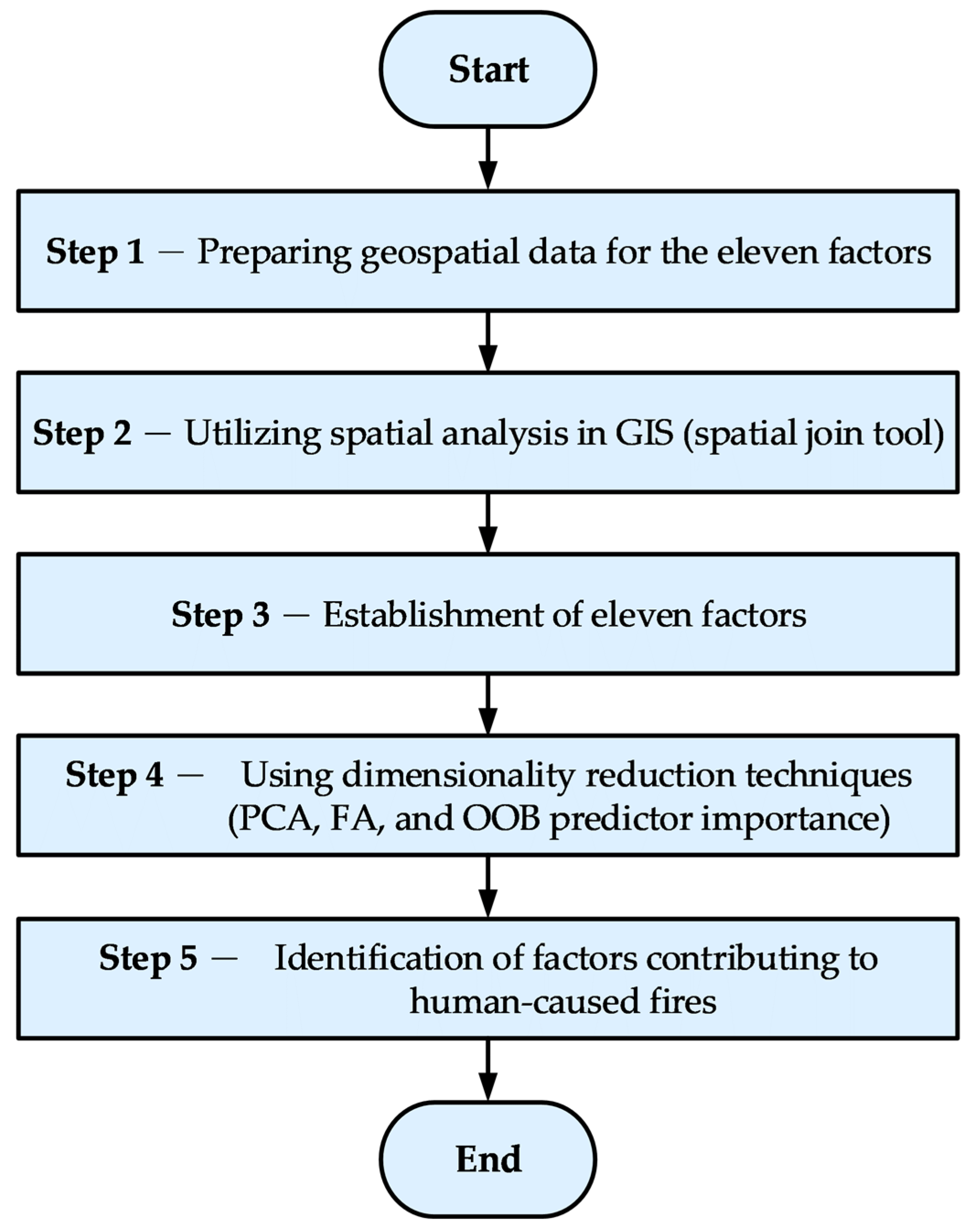
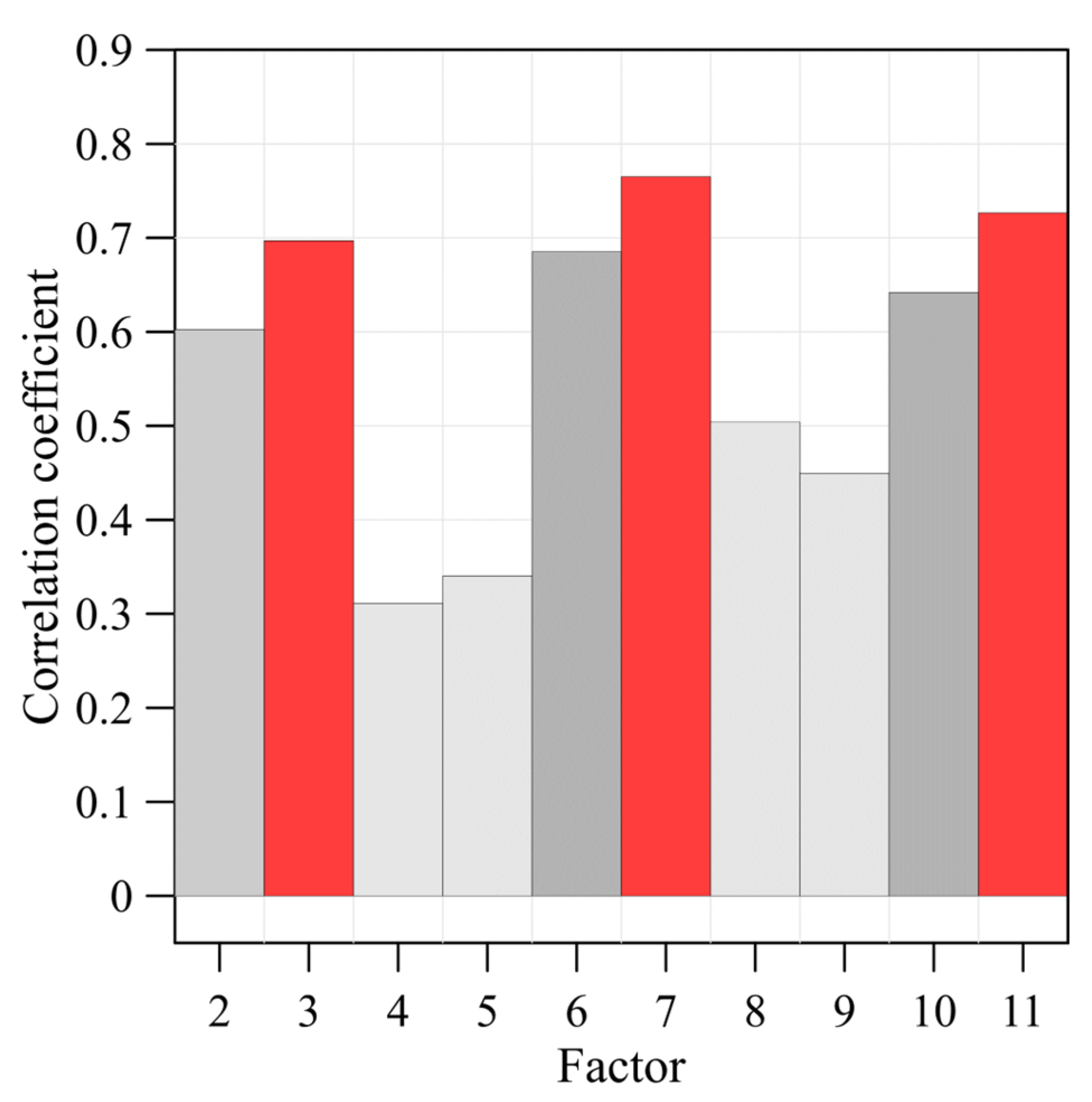
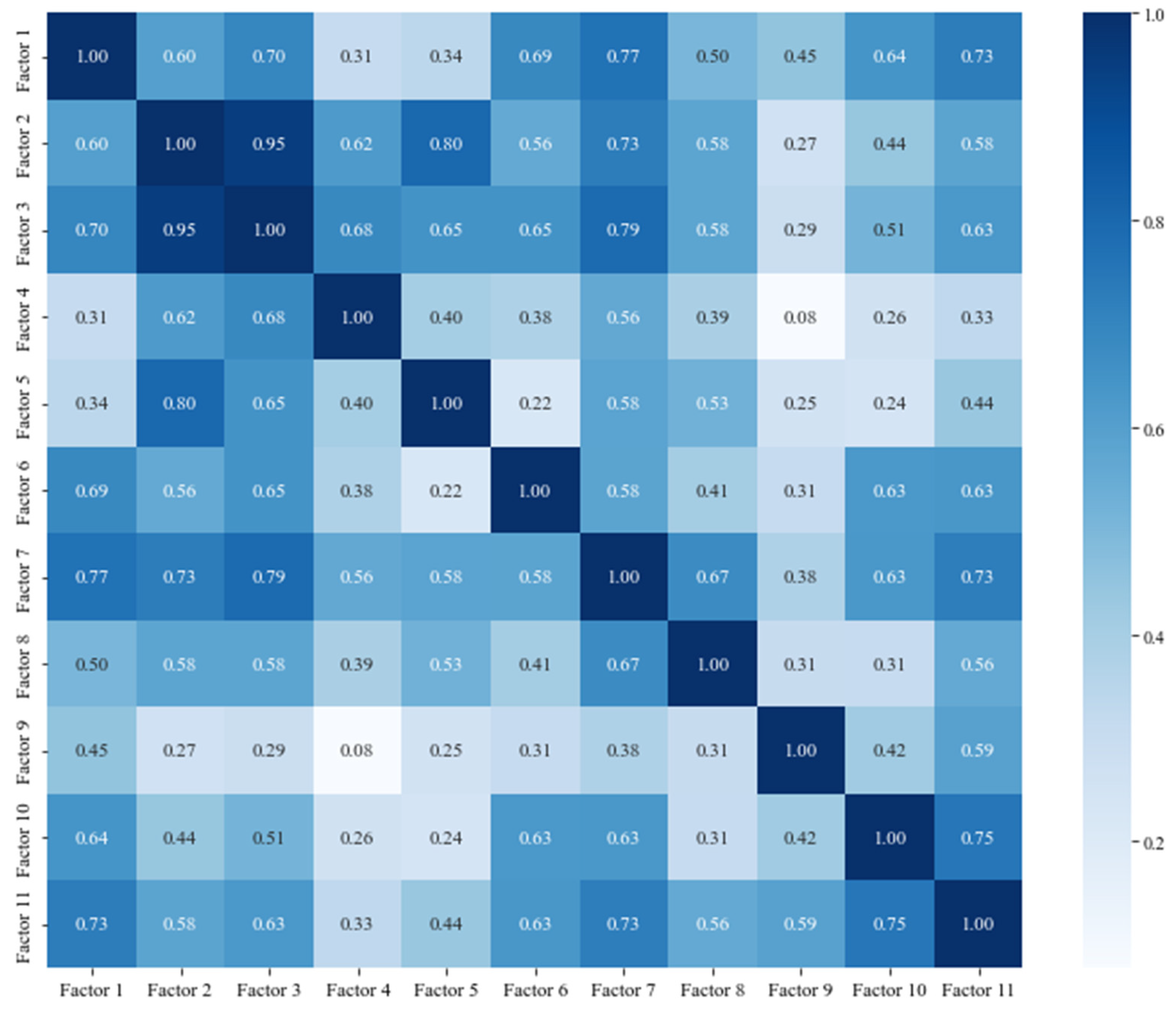
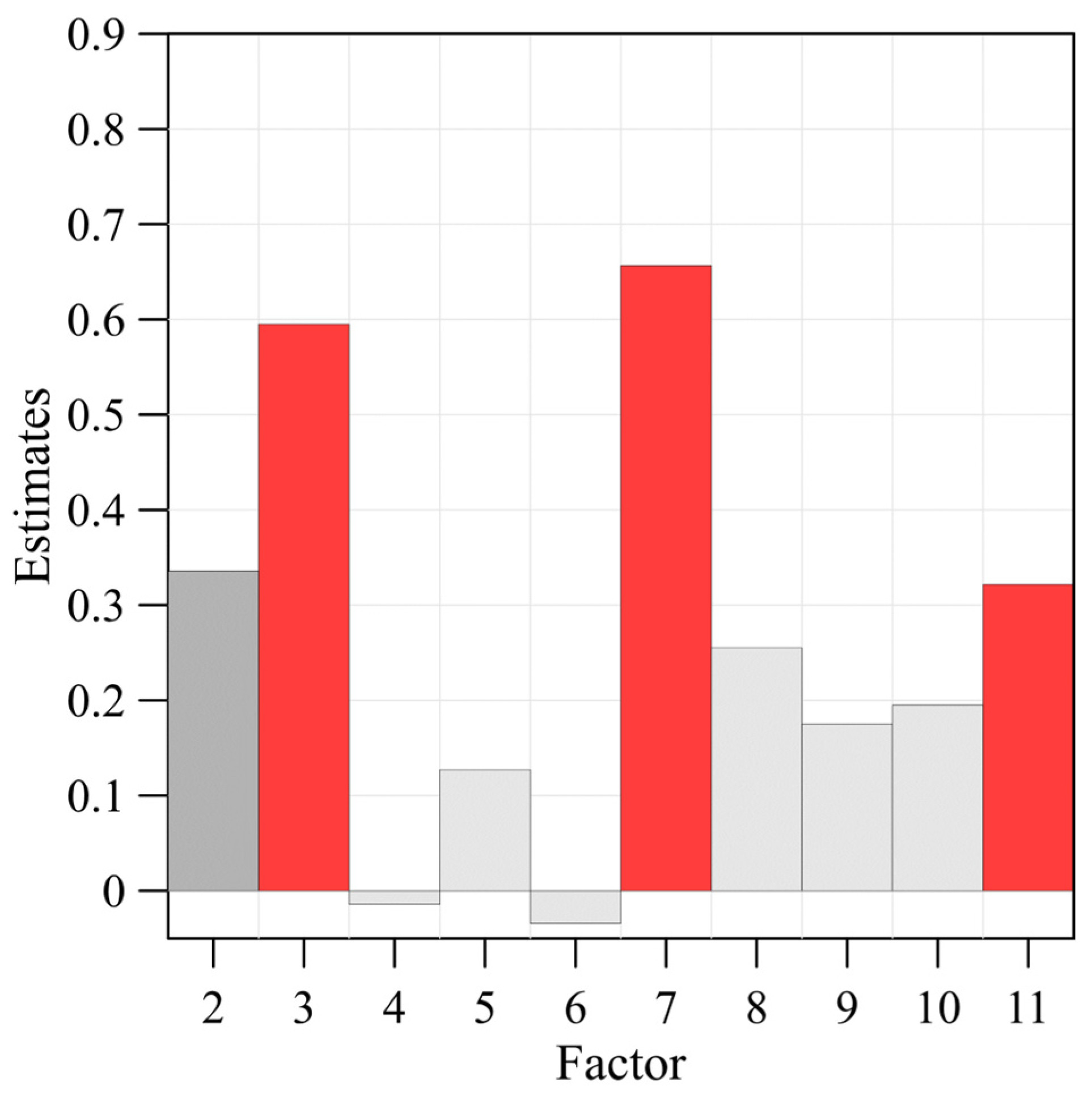
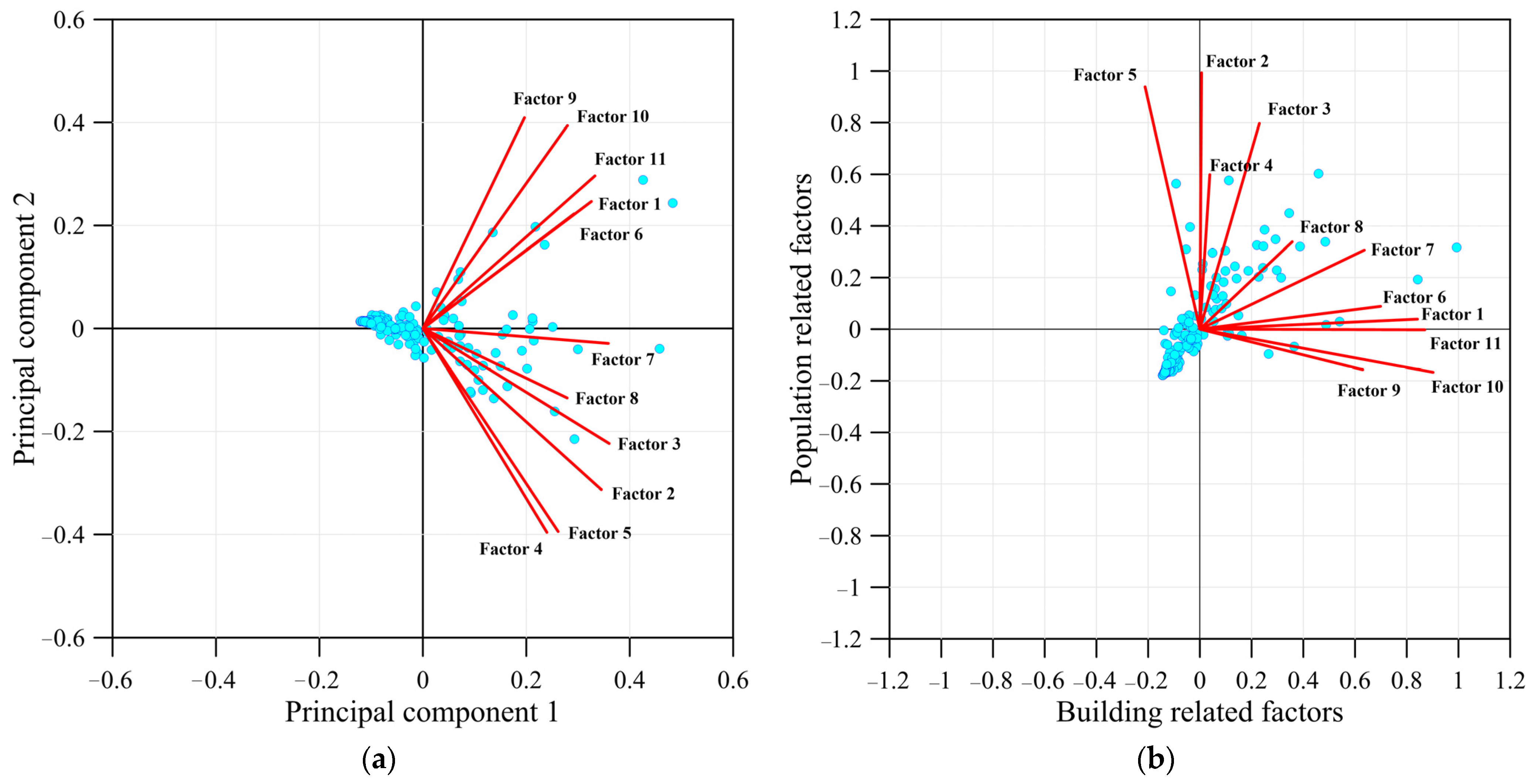

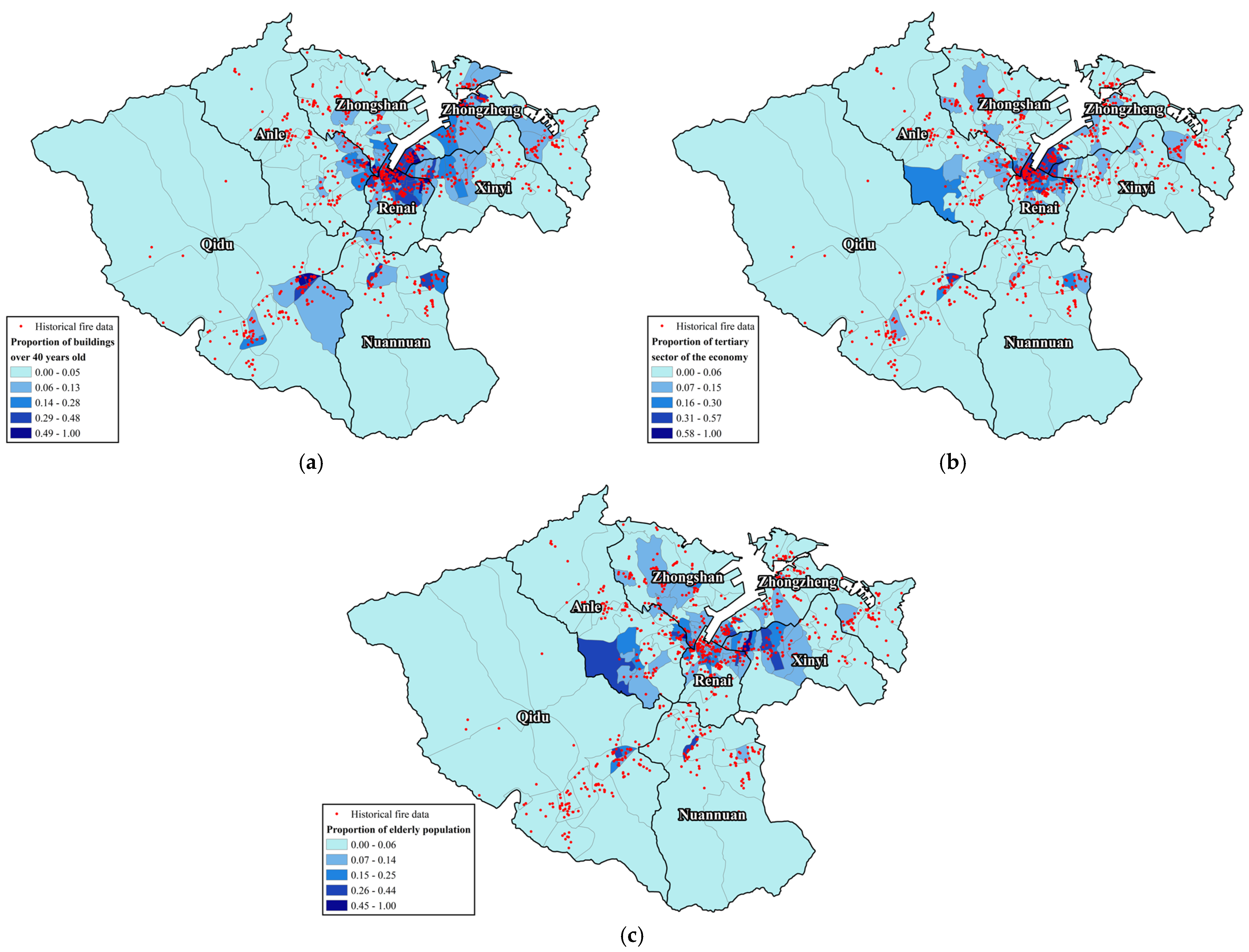
| Factor Description | Aquired Time | Source Data | |
|---|---|---|---|
| Factor 1 | Fire density over the past 10 years | 2021 | Keelung City Fire Bureau [16] |
| Factor 2 | Population density | 2021 | Household Registration Division, Department of Civil Affairs, Keelung City Government [43] |
| Factor 3 | Proportion of elderly population | 2021 | Household Registration Division, Department of Civil Affairs, Keelung City Government [43] |
| Factor 4 | Proportion of elderly living alone population | 2021 | Department of Social Affairs, Keelung City Government [46] |
| Factor 5 | Proportion of young age population | 2021 | Household Registration Division, Department of Civil Affairs, Keelung City Government [43] |
| Factor 6 | Building density | 2021 | Department of Urban Development, Keelung City Government [47] |
| Factor 7 | Proportion of buildings over 40 years old | 2021 | Department of Urban Development, Keelung City Government [47] |
| Factor 8 | Proportion of non-reinforced concrete (RC) buildings | 2021 | Department of Social Affairs, Keelung City Government [46] |
| Factor 9 | Proportion of first sector of the economy | 2021 | Department of Economic Affairs, Keelung City Government [48] |
| Factor 10 | Proportion of secondary sector of the economy | 2021 | Department of Economic Affairs, Keelung City Government [48] |
| Factor 11 | Proportion of tertiary sector of the economy | 2021 | Department of Economic Affairs, Keelung City Government [48] |
Disclaimer/Publisher’s Note: The statements, opinions and data contained in all publications are solely those of the individual author(s) and contributor(s) and not of MDPI and/or the editor(s). MDPI and/or the editor(s) disclaim responsibility for any injury to people or property resulting from any ideas, methods, instructions or products referred to in the content. |
© 2024 by the authors. Licensee MDPI, Basel, Switzerland. This article is an open access article distributed under the terms and conditions of the Creative Commons Attribution (CC BY) license (https://creativecommons.org/licenses/by/4.0/).
Share and Cite
Ku, C.-Y.; Lu, H.-C.; Tu, Y.-T.; Liu, C.-Y. Charactering Human-Caused Fires Using GIS-Based Dimensionality Reduction Techniques in Keelung City, Taiwan. Appl. Sci. 2024, 14, 1930. https://doi.org/10.3390/app14051930
Ku C-Y, Lu H-C, Tu Y-T, Liu C-Y. Charactering Human-Caused Fires Using GIS-Based Dimensionality Reduction Techniques in Keelung City, Taiwan. Applied Sciences. 2024; 14(5):1930. https://doi.org/10.3390/app14051930
Chicago/Turabian StyleKu, Cheng-Yu, Hsueh-Chuan Lu, Yi-Tse Tu, and Chih-Yu Liu. 2024. "Charactering Human-Caused Fires Using GIS-Based Dimensionality Reduction Techniques in Keelung City, Taiwan" Applied Sciences 14, no. 5: 1930. https://doi.org/10.3390/app14051930






